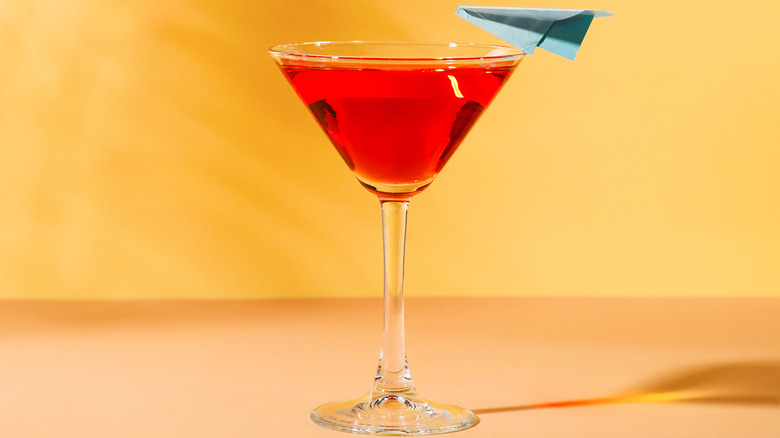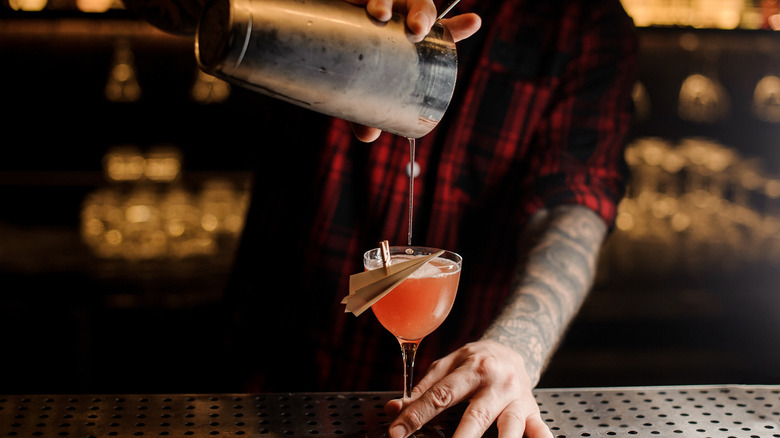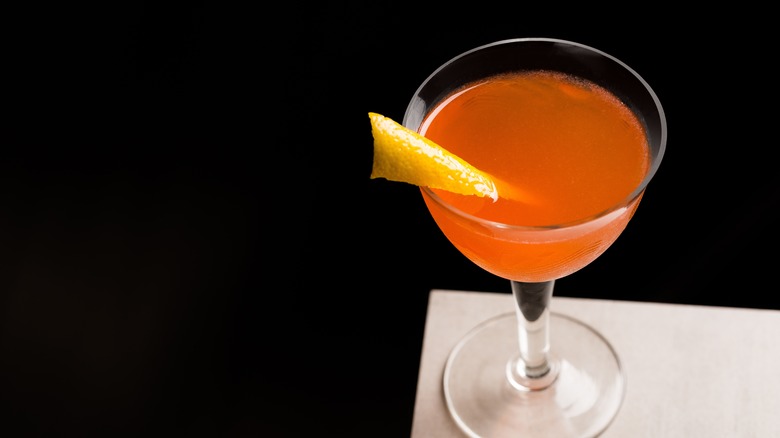What Is A Paper Plane Cocktail, And How Did It Get Its Name?
A paper plane might sound like a drink reserved for the cocktail in-crowd, but it has something in common with other well-known drinks like the Negroni, Bijou, Boulevardier, and Last Word that makes it surprisingly approachable. It's an "equal parts" recipe, made with three quarters of an ounce of the following –– bourbon, Amaro Nonino, Aperol, and lemon juice. So there's no need to be or even look like a seasoned mixologist to get one of these right.
If you're a fan of drinks like the whiskey sour, Aperol spritz, Negroni, and Last Word, you're bound to like this one too. Bourbon's bite, Amaro Nonino's herbal and citrus notes, Aperol's bright hue and bitterness, and the tartness from lemon combine to create a bittersweet, perfectly balanced drink. Sipping it is even more satisfying once you know how it got its name, which starts with one part 2008 hit song, two parts bartending genius, and a dash of late-night inebriation.
Yep, the paper plane got its name from a song
Sam Ross, the bartender famous for creating contemporary classics like the Penicillin cocktail – Scotch whisky, ginger, honey syrup, and lemon juice — is also credited with creating the Paper Plane. Legend has it that when Ross' old friend Toby Maloney was preparing to open The Violet Hour, a cocktail bar in Chicago, he called up Ross for a drink recipe. It was late, Ross was listening to "Paper Planes" on repeat, and a bit buzzed when he left the recipe on Maloney's voicemail and attached the name to the drink. Maloney, perhaps connecting it with other transportation-themed drink names like the Sidecar, Aviation, and Moscow Mule, felt it had an instant hook.
The goal of the recipe was to create a variation of the balanced and beautiful Last Word. Swaps like Amaro Nonino, with its Italian grappa (a type of brandy) base, added herbaceous and complex notes where Green Chartreuse usually would in the Last Word. Instead of Maraschino liqueur, the recipe originally included Campari, a much more bitter aperitif, which Aperol eventually replaced. It was a hit at The Violet Hour, and Ross' bar, New York's Milk & Honey. The love for the drink spread, so much so that a bar by the same name opened in 2014 in San Jose.
Making a paper plane (cocktail)
Crafting a Paper Plane is straightforward as long as you have its four ingredients. Simply add equal parts of each to a cocktail shaker with ice, shake it enough to cool and incorporate the parts (but so much to dilute it), and strain it into a chilled coupe or martini glass. If you already have the origami know-how to create a mini paper airplane to garnish the glass, you're sure to impress your guests, but a slickly cut citrus peel will look just as lovely.
The sky's the limit with variations on this equal-parts cocktail. One of the best-known is the Naked and Famous, which includes yellow Chartreuse instead of amaro, mescal instead of bourbon, lime juice instead of lemon, and Aperol, was dreamed up by another New York bartender, Joaquin Simo. You can also experiment with other variations that follow this formula, including fresh citrus juices like lemon, lime, blood orange, grapefruit, base spirits like gin, rum, whiskey, or vodka, an herbal liqueur like amaro or chartreuse, and an additional bitter liqueur like Cynar, Aperol, Campari, Maraschino, or Curaçao.


